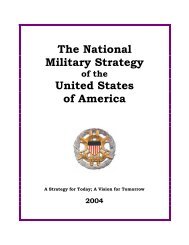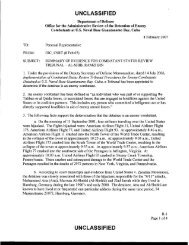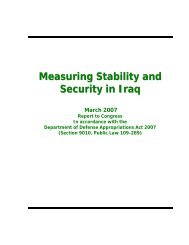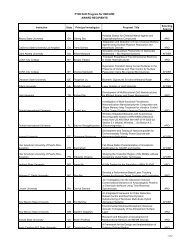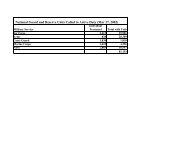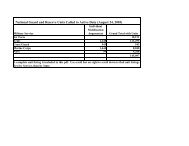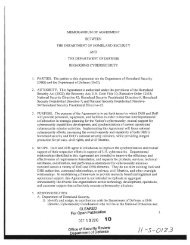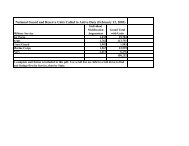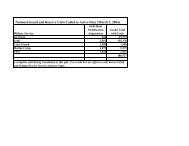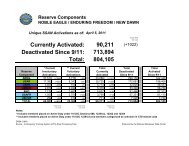Report - United States Department of Defense
Report - United States Department of Defense
Report - United States Department of Defense
You also want an ePaper? Increase the reach of your titles
YUMPU automatically turns print PDFs into web optimized ePapers that Google loves.
UNCLASSIFIED<br />
Pakistan Ground Lines <strong>of</strong> Communication (PAK GLOC), and the Air Lines <strong>of</strong> Communication<br />
(ALOC). The PAK GLOC is the most cost-effective route <strong>of</strong> the three, with the ALOCs being<br />
the most expensive though the fastest and most secure. The NDN GLOC is the slowest <strong>of</strong> the<br />
three and is only used for equipment located north <strong>of</strong> the Salang Tunnel.<br />
Several factors limit what types <strong>of</strong> cargo can traverse each route and influence route selection for<br />
various categories <strong>of</strong> equipment. All three routes are able to accept both rolling and non-rolling<br />
stock 4 , although sensitive and lethal cargo can only utilize the ALOC. Although the NDN can<br />
handle both rolling and non-rolling stock, rolling stock can only utilize the NDN-Russia route<br />
that departs the Hairatan Gate through Uzbekistan. Difficulties with both Uzbek border<br />
formalities and with the U.S. ability to meet agreed requirements have slowed the use <strong>of</strong> this<br />
route. In the past, PAK GLOC cargo has been frustrated at both the border crossing points and<br />
the ports. During the reporting period, the <strong>United</strong> <strong>States</strong> and Pakistan worked to resolve these<br />
issues. The ALOC is limited by the number <strong>of</strong> available aircraft and the ability to move<br />
equipment to the airports for departure.<br />
During this reporting period, the PAK GLOC was successfully opened to the retrograde <strong>of</strong><br />
materials. As <strong>of</strong> March 31, 2013, USFOR-A has sent 27 pieces <strong>of</strong> rolling stock across the border<br />
into Pakistan en route to the port <strong>of</strong> Karachi. Friction points still remain with the truckers’<br />
union and because <strong>of</strong> Pakistan government inefficiencies. Pakistan has previously closed<br />
borders and routes at various times. USFOR-A anticipates that the PAK GLOC will reach full<br />
outbound capacity by June 2013. Of the inbound cargo that had been stalled in Pakistan while<br />
the GLOC was closed, 80 percent has now crossed into Afghanistan.<br />
1.3: ISAF COMMAND AND CONTROL<br />
Several leadership changes have occurred during the reporting period or will occur in the near<br />
future within the ISAF command and control structure. In February 2013, General Joseph<br />
Dunford, USMC, assumed command <strong>of</strong> ISAF, replacing General John Allen. The following<br />
commanders will transition their authority to a successor during the next six months: Lieutenant<br />
General Dan Bolger (U.S.), Commander, NATO Training Mission–Afghanistan and Combined<br />
Security Transition Command–Afghanistan, Major General Mark Gurganus (U.S.), Commander,<br />
Regional Command Southwest (RC-SW); Major General Erich Pfeffer (Germay), Commander,<br />
RC-North (RC-N); Brigadier General Dario Rainieri (Italy), Commander, RC-West (RC-W); and<br />
Major General Robert B. Abrams (U.S.), Commander, RC-South (RC-S). In addition, Major<br />
General William Mayville (U.S.), Commander, RC-East (RC-E) conducted transfer <strong>of</strong> authority<br />
on March 14, 2013.<br />
In anticipation <strong>of</strong> the end <strong>of</strong> the ISAF mission, ISAF has established the NATO Afghanistan<br />
Transformation Task Force (NATTF), effective January 1, 2013. This task force will identify,<br />
plan, negotiate, implement and monitor current ISAF tasks prior to transition. NATTF will then<br />
facilitate the transformation, transfer, or termination <strong>of</strong> tasks to enable the transition from ISAF<br />
to the post-2014 NATO mission in Afghanistan.<br />
4 “Rolling Stock” refers to cargo that is able to travel by train.<br />
16



